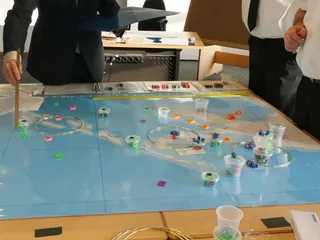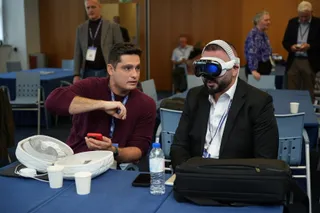Wired for War (#Not): A Light-Hearted Defence of Digital Wargaming
Contact Our Team
For more information about how Halldale can add value to your marketing and promotional campaigns or to discuss event exhibitor and sponsorship opportunities, contact our team to find out more
The Americas -
holly.foster@halldale.com
Rest of World -
jeremy@halldale.com

By Vice Admiral (ret.) Georgios Floros
Picture this: in a windowless war room filled with hex maps, model ships, and the mixed scents of brewed coffee and cardboard, professional warriors and wannabe strategists alike gathered to simulate battle. Dice clattered, rules debated with the intensity of a treaty negotiation, and people argued over and over in what seemed as a beautiful chaos. This is just a screenshot of the era of manual wargames. An era that has never been surpassed and it certainly brings nostalgic memories to those who have actually lived it.
Nowadays, many of these rooms glow with the blue light of monitors. Wargames are being run on software that models radar propagation, satellite latency, sea state, and even the operational behavior of a stealth drone in Arctic conditions. And while some embrace the change, others stand their ground—concerned that digital wargaming might be missing the point entirely.
Are they right? Or are we perhaps misjudging a new chapter in the art of simulated conflict? Let's consider the critiques, the counterpoints, and the curious case of the resurrected aircraft carrier. I have to make it clear though, that I am among the ones that hold vivid memories from cardboards, coffee and even cigarette smoke (we even had that back then) and I do believe in the power and benefits of manual wargaming. But with an open mind I let myself embrace the goodies of the digital realm hence the inspiration for this writing.
The Digital Wargaming Realm
Critics argue that digital wargaming creates a false sense of scientific rigor—an illusion of accuracy supported by graphs, charts, and visually stunning UI elements. They fear that behind the flash lies an opaque engine built on speculative assumptions and unverifiable models all on top of bits and bytes and Boolean algebra.
Let’s be honest. The real world is complicated. In the analog age, terrain was often a few colored contours on a map. In digital wargaming, terrain affects radar shadowing, line-of-sight, and even sound propagation. Weather, once a footnote, now dynamically shifts detection ranges and weapon accuracy.
And weapon systems? Digital simulations model their real-world parameters—acceleration, drag, seeker logic, midcourse guidance, and failure probabilities. Is it perfect? No. But it’s a lot closer to reality than a six-sided die.
Another common concern: the seductive certainty of the computer-generated outcome. Participants might trust the model too much, mistaking simulation for truth. I wouldn’t argue that if I didn’t know that the same goes with human umpires and adjudicators who, like wargame shamans, decide (based on what criteria?) if, for example, the last missile hit on a fictitious frigate was successful or not. Boolean logic from the human perspective.
Let us now recall a sobering lesson from history: the Japanese wargames conducted prior to the Battle of Midway. During those games, a US counterattack resulted in the simulated sinking of a Japanese aircraft carrier. The umpire—a man of great rank and likely little humility—declared the carrier had, in fact, survived. It was resurrected with a wave of the
hand and continued the wargame as if fate could be bullied into submission. We all know what happened in the actual battle of Midway don’t we?
Contrast this with today’s digital systems. They may be imperfect, but they don’t play favorites. Probabilistic outcomes are calculated from documented parameters and statistical models—not wishful thinking or personal bias. The AI doesn’t care if it’s your flagship.
A common lament is that digital games encourage players to focus on manipulating software rather than exploring operational judgment. This is more a matter of poor design than inherent digital flaw. A well-designed digital wargame pushes the player into uncomfortable decisions and unexpected dilemmas, all while relieving them from manual rule enforcement. Good digital wargaming doesn’t eliminate uncertainty—it models it.
And let’s not forget: in manual games, the cognitive burden often lies in remembering rules, adjusting counters, or figuring out how much fuel an aircraft has left. This kind of logistics is almost impossible to do manually and is the bread and butter of digital simulations, which can automate those mechanics so the player can focus on strategic decisions. The friction remains—just more usefully placed.
Sweet Spot: Hybrid Wargaming
Then there is the accusation that you have to learn the software and sometimes (well actually most of the time) the learning curve is so steep it's discouraging. This one’s undeniably true. Digital systems do have learning curves. You can’t just show up, grab a pencil, and start. But here’s the sweet spot: hybrid wargaming, where an expert operator from the White Cell participates to take the mechanical burden off the participants.
Wargaming is About Shaking Minds
Manual games are intuitive and accessible. No logins, no updates, no IT support. That’s a real strength, especially in educational or rapid-prototype settings. Combine the intuitive nature of manual play with the rigor and repeatability of digital systems. Use human-led tabletop decisions, but plug the outcomes into digital adjudication engines that handle the complexity of detection models, terrain effects, and weapon physics. You get the best of both worlds: insight and rigor, accessibility and depth.
Another accusation often heard is that digital games accelerate play at the expense of participant interaction causing loss of human dialogue. Automated adjudication replaces the debates and discussions where learning happens. Well, that’s what facilitators are for. Digital adjudication doesn’t preclude dialogue—it frees up time for it. When you’re not arguing over who forgot the fuel penalty or which hex had line-of-sight, you can actually discuss what happened and why.
Wargaming isn’t about moving pieces—it’s about shaking minds. The real value lies in the debrief, the self-questioning, the postmortem. Digital speeds the play, but again it’s up to the players to choose their own pace.
Strengths and Weaknesses of the Two Worlds
When it comes to the strengths and weaknesses of the two worlds it seems that manual is better at strategic level, ill-defined problems. The more vague the problem the better manual is. Digital is better for more formulaic operations, kinetic type simulations and anything lower level. Digital lets you generate vast amounts of data if that's what you want. Manual is good for qualitative answers while digital is good for quantitative. Digital lets you repeat the wargame many times with or without humans in the loop to verify results. For example, is it what happened to the 0.1% chance, or is it the likely outcome? Without the ability to run the scenario multiple times you can't tell if your outcome was just a lucky hit that can be ignored or is a fundamental truth of the future war.
In terms of scalability, manual wargames require every person in the command chain to be a real person meaning large staffs are required to make anything happen. Digital can automate the levels you are not concerned with using AI. I'm not saying these AI agents will make good decisions, but it doesn't matter as the outcomes to some extent are irrelevant and it's about the learning they offer to the players. Manual staff exercises tend to involve lots of waiting for something to happen or being on rails to deliver the training required and are so expensive they can't get in the reps.
Manual and Digital Wargaming as Co-Workers
I need to add my final thought here: Manual and digital wargaming aren’t at war. No ma’am they aren’t. They’re co-workers in the business of strategic education and operational insight. Long story short: this isn’t a battle – it’s an evolution.
Digital or manual makes no difference when it comes to wargaming. You either roll a dice or let the simulation determine the outcomes. The same support staff with the same skill sets in the room, the same umpires etc. Digital does allow you to scale back on the support staff if you want but that’s a decision open to the game designer and important to take into account what it is you want to get out of the wargame.
Yes, manual games are tactile, improvisational, and great for learning the basics. But when realism, complexity, and repeatability matter—when you want to test assumptions under near-operational conditions—digital games deliver.
They don’t remove the human from the loop. They remove the human from the paperwork.
This is not a tradition vs. technology debate. Let’s see it as chalk and tablet, map and monitor, dice and dataset—all in the service of better decisions and sharper minds.
Because in the end, it’s not about how the game is played. It’s about what you learn when it’s over.
And no one, we hope, is resurrecting aircraft carriers anymore.
[Editor’s note: Vice Admiral (ret.) Georgios Floros is Senior Defence Advisor at Slitherine / Matrix Games. A graduate of the Hellenic Naval Academy, the retired flag officer served more than 40 years in the Hellenic Navy in ever-increasing positions of responsibility. The retired vice admiral brings to his industry position extensive experience in real-world operations, leadership, intelligence, defence, and strategic planning. The retired flag officer’s final assignment while on active duty was the Honorable Deputy Chief of the Hellenic Navy General Staff.]


